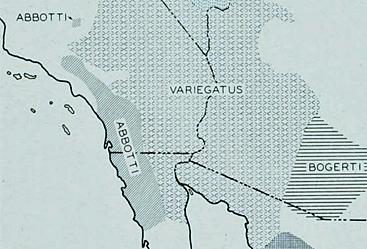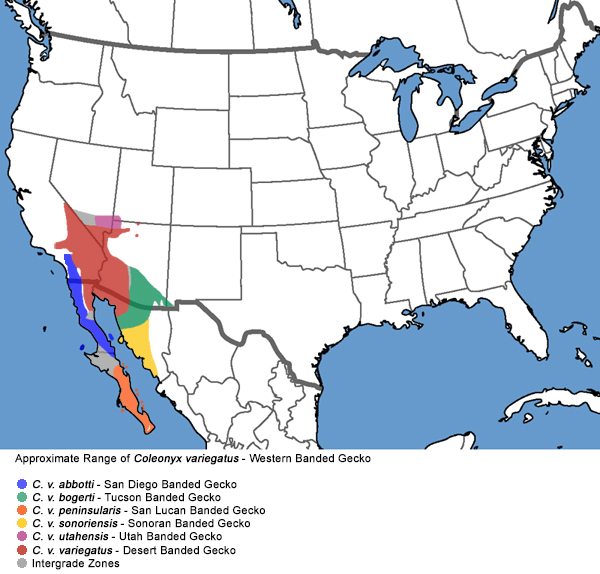Western Banded Gecko - Coleonyx variegatus
Desert Banded Gecko - Coleonyx variegatus variegatus
(Baird, 1859)Description • Taxonomy • Species Description • Scientific Name • Alt. Names • Similar Herps • References • Conservation Status
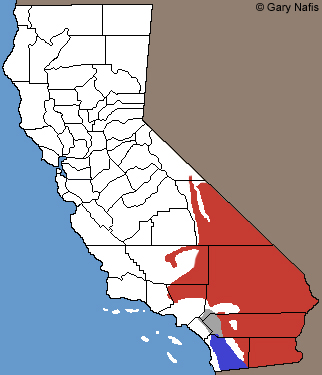
Red: Range of this subspecies in California
Coleonyx variegatus variegatus - Desert Banded Gecko
Range of the other subspecies:
Dark Blue: Coleonlyx variegatus abbotti -
San Diego Banded Gecko
Gray: Approximate intergrade area
Click on the map for a topographical view
Map with California County Names

Listen to this Gecko
 |
|||||||||||||||||||||||||||||||||||||||||||||||||||||||
| Adult, eastern Riverside County desert | |||||||||||||||||||||||||||||||||||||||||||||||||||||||
 |
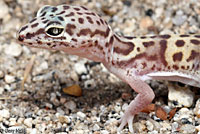 |
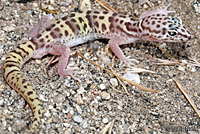 |
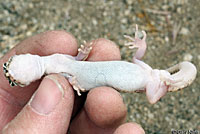 |
||||||||||||||||||||||||||||||||||||||||||||||||||||
| Adult, eastern Riverside County desert | |||||||||||||||||||||||||||||||||||||||||||||||||||||||
 |
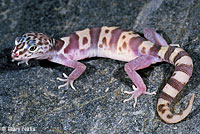 |
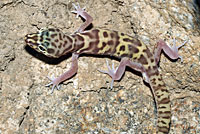 |
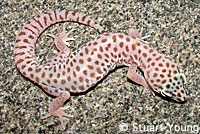 |
||||||||||||||||||||||||||||||||||||||||||||||||||||
| Adult, Inyo County desert | Adult, San Diego County desert | Spotted adult - with no bands, Imperial County. © Stuart Young |
|||||||||||||||||||||||||||||||||||||||||||||||||||||
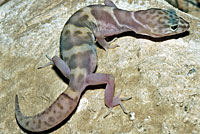 |
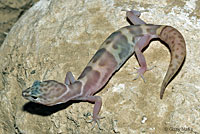 |
 |
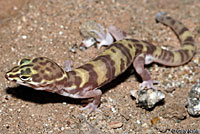 |
||||||||||||||||||||||||||||||||||||||||||||||||||||
| Adult, Inyo County | Adult female, Imperial County | Adult, San Diego County | |||||||||||||||||||||||||||||||||||||||||||||||||||||
 |
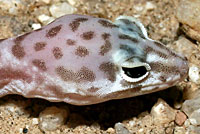 |
 |
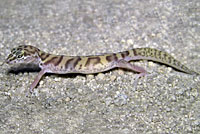 |
||||||||||||||||||||||||||||||||||||||||||||||||||||
| Adult male, Imperial County | Adult, Imperial County | Adult, Imperial County | |||||||||||||||||||||||||||||||||||||||||||||||||||||
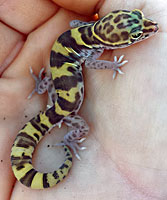 |
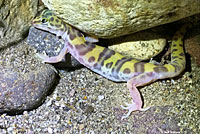 |
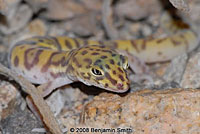 |
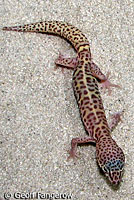 |
||||||||||||||||||||||||||||||||||||||||||||||||||||
| Adult from near Canyon Country, Los Angeles County © Anonymous |
Adult, Santa Clarita, Los Angeles County © Jeff Ahrens |
Adult, San Bernardino County desert © Ben Smith |
Adult, eastern Riverside County desert © Geoff Fangerow |
||||||||||||||||||||||||||||||||||||||||||||||||||||
 |
 |
 |
 |
||||||||||||||||||||||||||||||||||||||||||||||||||||
| Adult, San Diego County desert © Patrick Briggs |
Gravid adult female, Mono County © Keith Condon | Adult, Riverside County © Brody Trent |
|||||||||||||||||||||||||||||||||||||||||||||||||||||
 |
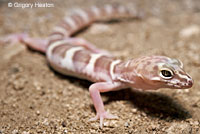 |
 |
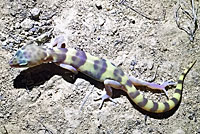 |
||||||||||||||||||||||||||||||||||||||||||||||||||||
| Adult, Inyo County © Grigory Heaton |
Adult, Riverside County © Grigory Heaton |
Banded geckos are not known for climbing as well as other kinds of geckos, such as the Hemidactylus, but it is not uncommon to find them sheltering in cracks or under caps on large boulders that they have climbed. This adult male (notice the spur at the base of his tail) is hiding in an elevated rock crack in the Eastern Sierra Nevada Mountains in Inyo County © Noah Morales. |
This adult was reportedly found west of the known range of the species in the hills between Simi Valley and Hwy 101 near Thousand Oaks in Ventura County in June 2016. Locations this specific are not typically mentioned here, but I'm hoping that someone will be inspired to search the area to confirm that banded geckos are there then let me know. | ||||||||||||||||||||||||||||||||||||||||||||||||||||
 |
 |
 |
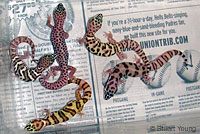 |
||||||||||||||||||||||||||||||||||||||||||||||||||||
| Adult, Los Angeles County Mountains © Ryan Sikola | This bright yellow adult was found in Imperial County at the Colorado River near Yuma. © Brian Hubbs | These adult geckos illustrate how variable the colors and patterns of this species can be. © Stuart Young | |||||||||||||||||||||||||||||||||||||||||||||||||||||
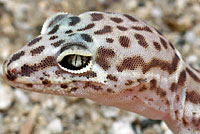 |
 |
||||||||||||||||||||||||||||||||||||||||||||||||||||||
| Adult, eastern Riverside County desert. Note that Desert Banded Geckos have moveable eyelids and vertical pupils. |
|||||||||||||||||||||||||||||||||||||||||||||||||||||||
Juveniles |
|||||||||||||||||||||||||||||||||||||||||||||||||||||||
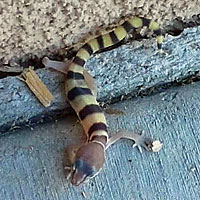 |
 |
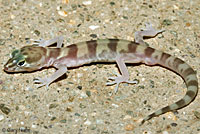 |
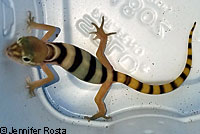 |
||||||||||||||||||||||||||||||||||||||||||||||||||||
| Juvenile, Santa Clarita, Los Angeles County |
Juvenile, eastern Kern County | Juvenile, Imperial County | Juvenile, San Bernardino County © Jennifer Rosta |
||||||||||||||||||||||||||||||||||||||||||||||||||||
 |
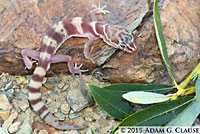 |
 |
 |
||||||||||||||||||||||||||||||||||||||||||||||||||||
| Juvenile male, Mono County © Adam G. Clause |
Subadult male, Mono County © Adam G. Clause |
Juvenile, L.A. County desert © Janet Ellis | |||||||||||||||||||||||||||||||||||||||||||||||||||||
| Comparisons of Banded Geckos in California Also see Banded Geckos in California - Genus Coleonyx |
|||||||||||||||||||||||||||||||||||||||||||||||||||||||
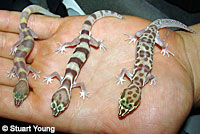 |
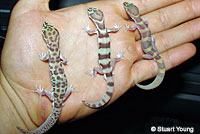 |
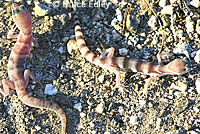 |
|||||||||||||||||||||||||||||||||||||||||||||||||||||
| Left: San Diego Banded Gecko Middle: Intergrade Right: Desert Banded Gecko All three were found in Baja California where the ranges of the two subspecies meet. © Stuart Young |
Right: San Diego Banded Gecko Middle: Intergrade Left: Desert Banded Gecko All three were found in Baja California where the ranges of the two subspecies meet. © Stuart Young |
Desert Banded Gecko - left San Diego Banded Gecko - right © Bruce Edley |
|||||||||||||||||||||||||||||||||||||||||||||||||||||
| © Nathan Smith | © Stuart Young | ||||||||||||||||||||||||||||||||||||||||||||||||||||||
 |
 |
 |
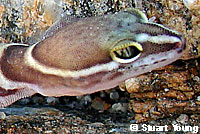 |
||||||||||||||||||||||||||||||||||||||||||||||||||||
| Desert Banded Gecko (C. v. variegatus) Adults have large dark markings on the head (but juvenile heads are plain or lightly spotted.) The nuchal loop extending around the head from the eyes is irregular or not present. |
San Diego Banded Gecko (C. v. abbotti) The head does not have large dark markings. A light-colored clearly-defined nuchal loop extends from the eyes around the back of the head. |
||||||||||||||||||||||||||||||||||||||||||||||||||||||
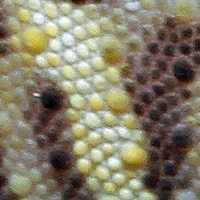 |
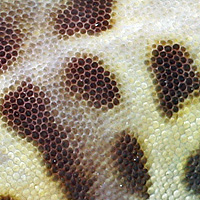 |
||||||||||||||||||||||||||||||||||||||||||||||||||||||
| Peninsula Banded Gecko - C. s. switaki Skin is smooth with small granular scales interspersed with larger tubercles. |
Desert Banded Gecko - C.variegatus Skin is smooth with small granular scales that are not interspersed with larger tubercles. |
||||||||||||||||||||||||||||||||||||||||||||||||||||||
| Difference Between Males and Females | |||||||||||||||||||||||||||||||||||||||||||||||||||||||
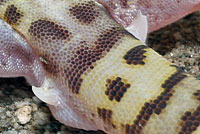 |
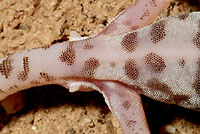 |
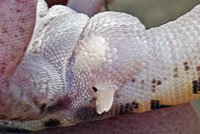 |
 |
||||||||||||||||||||||||||||||||||||||||||||||||||||
| Males have spurs at the base of the tail. Females do not. Compare |
Gravid adult female, Mono County. You can see some eggs in her lower body. © Keith Condon | ||||||||||||||||||||||||||||||||||||||||||||||||||||||
| Habitat | |||||||||||||||||||||||||||||||||||||||||||||||||||||||
 |
 |
 |
 |
||||||||||||||||||||||||||||||||||||||||||||||||||||
| Habitat, San Diego County |
Habitat, San Diego County |
Habitat, San Bernardino County | Habitat, Imperial County desert | ||||||||||||||||||||||||||||||||||||||||||||||||||||
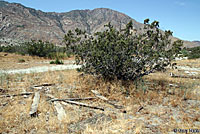 |
 |
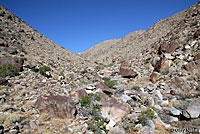 |
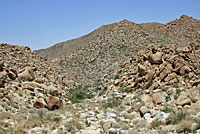 |
||||||||||||||||||||||||||||||||||||||||||||||||||||
| Habitat, Riverside County | Habitat, Inyo County | Habitat, San Diego County | Habitat, Imperial County | ||||||||||||||||||||||||||||||||||||||||||||||||||||
 |
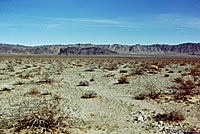 |
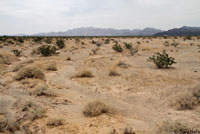 |
|||||||||||||||||||||||||||||||||||||||||||||||||||||
| Habitat, Imperial County | Habitat, Riverside County |
Habitat, Imperial County | |||||||||||||||||||||||||||||||||||||||||||||||||||||
| Short Videos | |||||||||||||||||||||||||||||||||||||||||||||||||||||||
 |
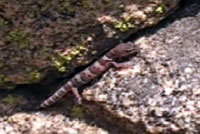 |
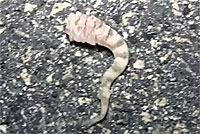 |
|||||||||||||||||||||||||||||||||||||||||||||||||||||
| A night shot of a gecko crawling slowly and waving its tail as a distraction. |
Three Desert Banded Geckos out at night in the desert. |
Watch a short video of a Western Banded Gecko intergrade crawling along a boulder in Riverside County. | This shows the detached tail of a Desert Banded Gecko wriggling rapidly in a defensive measure used to distract a potential predator to chase the tail and not the lizard's more vital head and body. The lizard was found on a highway after it was recently killed by a vehicle. The tail was partly severed and wriggling. When the tail was completely detached from the body, it continued wriggling as it was blown across the asphalt by a strong wind. Once the wriggling started winding down the tail was put into an automobile to keep it out of the wind as it slowly stopped moving. The video has been edited down from about 6 minutes. | ||||||||||||||||||||||||||||||||||||||||||||||||||||
|
|||||||||||||||||||||||||||||||||||||||||||||||||||||||
|
|||||||||||||||||||||||||||||||||||||||||||||||||||||||
|
The following conservation status listings for this animal are taken from the July 2025 State of California Special Animals List and the July 2025 Federally Listed Endangered and Threatened Animals of California list (unless indicated otherwise below.) Both lists are produced by multiple agencies every year, and sometimes more than once per year, so the conservation status listing information found below might not be from the most recent lists, but they don't change a great deal from year to year.. To make sure you are seeing the most recent listings, go to this California Department of Fish and Wildlife web page where you can search for and download both lists: https://www.wildlife.ca.gov/Data/CNDDB/Plants-and-Animals. A detailed explanation of the meaning of the status listing symbols can be found at the beginning of the two lists. For quick reference, I have included them on my Special Status Information page. If no status is listed here, the animal is not included on either list. This most likely indicates that there are no serious conservation concerns for the animal. To find out more about an animal's status you can also go to the NatureServe and IUCN websites to check their rankings. Check the current California Department of Fish and Wildlife sport fishing regulations to find out if this animal can be legally pursued and handled or collected with possession of a current fishing license. You can also look at the summary of the sport fishing regulations as they apply only to reptiles and amphibians that has been made for this website. This animal is not included on the Special Animals List, which indicates that there are no significant conservation concerns for it in California. |
||
| Organization | Status Listing | Notes |
| NatureServe Global Ranking | ||
| NatureServe State Ranking | ||
| U.S. Endangered Species Act (ESA) | None | |
| California Endangered Species Act (CESA) | None | |
| California Department of Fish and Wildlife | None | |
| Bureau of Land Management | None | |
| USDA Forest Service | None | |
| IUCN | ||
|
|
||
Return to the Top
© 2000 -



